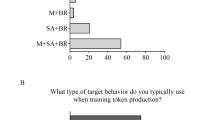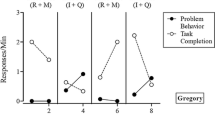Abstract
The purpose of this study was to: (a) compare student-administered token programs with similar programs administered by professional teachers, (b) investigate the contribution of feedback to the success of token systems, (c) compare the effectiveness of peer and teacher feedback, and (d) test a sequence of withdrawal from token programs designed to increase generalization. Results indicated that (a) peers could do just as well as teachers in reducing disruptive behavior through a token program, (b) feedback is not solely responsible for the effectiveness of token reinforcement, (c) peer feedback may be more effective than teacher feedback, and (d) withdrawal from token reinforcement to feedback may be a successful method of retarding the increases in disruptive behavior usually found when backup reinforcers are eliminated.
Similar content being viewed by others
References
Axelrod, S., Hall, R. V., & Maxwell, A. Use of peer attention to increase study behavior. Unpublished manuscript, University of Kansas, 1971.
Bushell, D., Wrobel, P. A., & Michaelis, M. L. Applying “group” contingencies to the classroom study behavior of preschool children.Journal of Applied Behavior Analysis, 1968,1, 55–61.
Hall, R. V., Fox, R., Willard, D., Goldsmith, L., Emerson, M., Owen, M., Davis, F., & Porcia, E. The teacher as observer and experimenter in the modification of disputing and talking-out behaviors.Journal of Applied Behavior Analysis, 1971,4, 141–149.
Haring, N., & Hauck, M. Improved learning conditions in the establishment of reading skills with disabled readers.Exceptional Children, 1969,35, 341–352.
Kaufman, K., & O'Leary, K. D. Reward, cost, and selfevaluation procedures for disruptive adolescents in a psychiatric hospital school.Journal of Applied Behavior Analysis, 1972,5, 293–309.
O'Leary, K. D., & Becker, W. C. Behavior modification of an adjustment class: A token reinforcement program.Exceptional Children, 1967,33, 637–642.
O'Leary, K. D., Becker, W., Evans, M., & Saudargas, R. A token reinforcement program in a public school: A replication and systematic analysis.Journal of Applied Behavior Analysis, 1969,2, 3–13.
O'Leary, K. D., & Drabman, R. Token reinforcement programs in the classroom: A review.Psychological Bulletin, 1971,75, 379–398.
O'Leary, K. D., Kaufman, K. F., Kass, R. E., & Drabman, R. S. The effects of loud and soft reprimands on the behavior of disruptive students.Exceptional Children, 1970,37, 145–155.
Patterson, G. R. An application of conditioning techniques to the control of a hyperactive child. In L. P. Ullmann & L. Krasner (Eds.),Case studies in behavior modification. New York: Holt, Rinehart & Winston, 1965.
Phillips, E., Bailey, J., & Wolf, M. Achievement Place: A token economy in a home-style rehabilitation program for juvenile offenders. Paper presented at the American Psychological Association Convention, Washington, D.C., 1969.
Phillips, E. L., & Wolf, M. M. Modification of behavioral deficiencies in adolescents. Paper presented at the American Psychological Association Convention, San Francisco, 1968.
Quay, H. C., Sprague, R. L., Werry, J. S., & McQueen, M. M. Conditioning visual orientation of conduct problem children in the classroom.Journal of Experimental Child Psychology, 1967,5, 512–517.
Smith, D. E. P., Brethower, D., & Cabot, R. Increasing task behavior in a language arts program by providing reinforcement.Journal of Experimental Child Psychology, 1969,8, 45–62.
Surratt, P. R., Ulrich, R. E., & Hawkins, R. P. An elementary student as a behavioral engineer.Journal of Applied Behavior Analysis, 1969,2, 85–92.
Wasik, B. The application of Premack's generalization on reinforcement to the management of classroom behavior.Journal of Experimental Child Psychology, 1970,10, 33–43.
Author information
Authors and Affiliations
Additional information
The project was supported by Grant OEG 0-71-2872 (607) from the U.S. Department of Education and Department of Health, Education, and Welfare. The opinions expressed herein, however, do not necessarily reflect the position or policy of the U.S. Office of Education, and no official endorsement by that Office should be inferred. The author would like to thank Drs. L. Krasner, A. O. Ross, and K. Feldman for their assistance throughout the study, and Dr. K. D. O'Leary for his invaluable help. Also gratefully acknowledged is the help of R. Spitalnik, R. Kent, M. Hageman. S. Ransom, W. Kaler, S. Golembeski and E. Howard.
Rights and permissions
About this article
Cite this article
Drabman, R.S. Child- versus teacher-administered token programs in a psychiatric hospital school. J Abnorm Child Psychol 1, 68–87 (1973). https://doi.org/10.1007/BF00917891
Issue Date:
DOI: https://doi.org/10.1007/BF00917891




